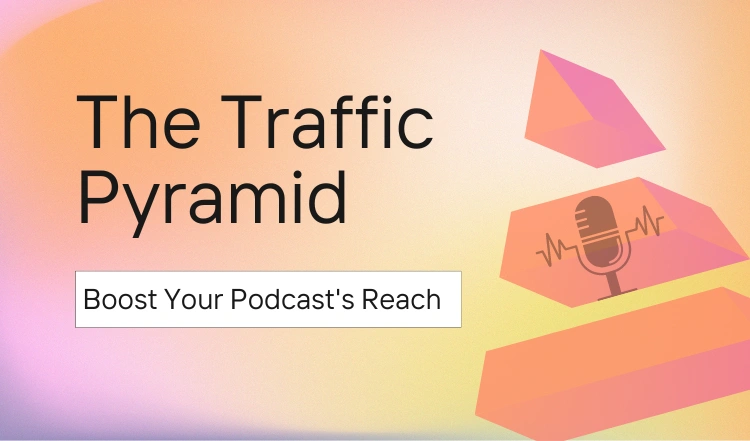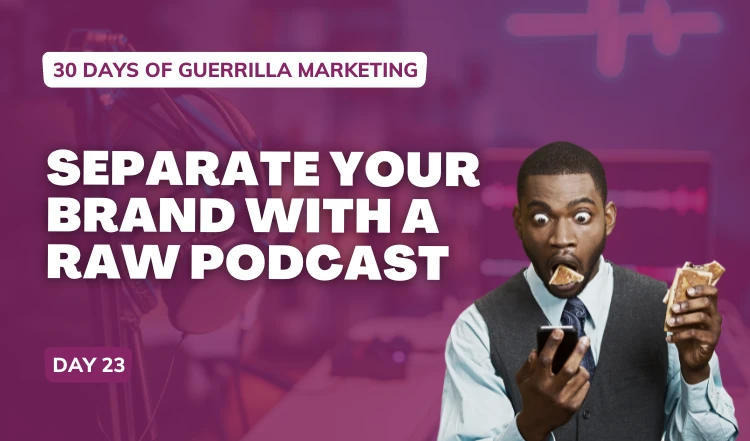Creating a successful podcast requires more than just producing great content. While creating engaging and informative episodes is essential, it’s only the first step in building an audience. To truly grow your podcast’s reach, you need to understand the concept of the traffic pyramid.
The traffic pyramid is a framework that can help you visualize the different levels of engagement your audience has with your podcast. At the base of the pyramid are the listeners who have just discovered your podcast, while at the top are the loyal fans who regularly engage with your content and share it with others. Understanding the traffic pyramid can help you identify where your audience is coming from, as well as where you should focus your efforts to reach new listeners.
In this article, we’ll take a closer look at the traffic pyramid and its importance in growing your podcast audience. We’ll explore each level of the pyramid and offer strategies for attracting and retaining listeners at each stage. By the end of this article, you’ll have a better understanding of how to use the traffic pyramid to build a thriving and engaged podcast community.
What is the Traffic Pyramid?

The Traffic Pyramid is a concept used to describe the four tiers of audience growth for a podcast. Each tier builds upon the previous one and provides a framework for podcasters to grow their audience and increase their reach.
The four tiers of the Traffic Pyramid are passive organic marketing, active organic marketing, leveraging other people’s audiences, and scaling with paid ads.
Passive Organic Marketing
Passive organic marketing is the first tier of the Traffic Pyramid. It involves creating high-quality content that will attract listeners to your podcast naturally. This tier is all about creating content that is search engine optimized, has a catchy title and thumbnail, and is shareable on social media. The key here is to make it easy for your existing listeners to share your content with their friends and family.
Active Organic Marketing
Active organic marketing is the second tier of the Traffic Pyramid. This tier involves actively promoting your podcast to your existing audience. This could involve creating a call-to-action at the end of your episodes, asking your listeners to leave a review, or promoting your podcast on social media. The goal of active organic marketing is to turn your existing listeners into loyal fans who will help spread the word about your podcast.
Leveraging Other People’s Audiences
The third tier of the Traffic Pyramid involves leveraging other people’s audiences. This means reaching out to other podcasters, bloggers, or influencers in your niche and asking them to promote your podcast to their audience. This could involve doing a guest interview on another podcast or writing a guest post on a popular blog. The key here is to find influencers who have a similar audience to yours and who are willing to promote your podcast.
Scaling with Paid Ads
The fourth and final tier of the Traffic Pyramid is scaling with paid ads. This tier involves using paid advertising to reach a larger audience. This could involve running ads on social media platforms or using Google Ads to target specific keywords related to your podcast. The key here is to have a clear understanding of your target audience and to create ad campaigns that are highly targeted and optimized for conversions.
By understanding the four tiers of the Traffic Pyramid, podcasters can develop a comprehensive strategy for growing their audience and increasing their reach. Each tier provides a unique opportunity to reach new listeners and build a loyal following for your podcast.
Tier 1: Passive Organic Marketing
The first tier of the traffic pyramid is passive organic marketing. It involves creating high-quality content that is search engine optimized and shareable. This means that the content is designed to attract organic traffic from search engines like Google, Bing, and Yahoo, as well as from social media platforms like Facebook, Twitter, and Instagram.
To make your content search engine optimized, you need to identify the right keywords to target. These are the words or phrases that people use to search for topics related to your podcast. You can use tools like Google Keyword Planner or Ahrefs to identify relevant keywords with high search volumes and low competition.
Once you’ve identified your target keywords, you need to optimize your content by including them in your title, description, and throughout the body of your podcast episode or blog post. This helps search engines to understand the topic of your content and rank it higher in search results.
In addition to being search engine optimized, your content should also be shareable. This means that it is easy for people to share your podcast episode or blog post with their friends, family, or followers on social media.
You can make your content shareable by including social sharing buttons on your website or blog, and by creating visually appealing images or videos to accompany your content.
Two Podcasters Who Successfully Used Passive Organic Marketing To Grow:
- “The Tim Ferriss Show” is a podcast that has grown to become one of the most popular shows in the world. Tim Ferriss credits a lot of his success to creating high-quality content that is optimized for search engines and easily shareable on social media.
- The “Entrepreneur on Fire” podcast hosted by John Lee Dumas is an excellent example of a podcast that relies heavily on passive organic marketing. The show features interviews with successful entrepreneurs, and Dumas focuses on producing high-quality content that is search engine optimized and shareable on social media. The show’s website features a blog with show notes and transcripts for each episode, which helps with search engine optimization. The show also has a strong social media presence, which helps it to get shared and discovered by new listeners.
Overall, passive organic marketing is an important part of the traffic pyramid because it helps you to attract high-quality traffic to your podcast without having to spend money on advertising. By creating high-quality content that is search engine optimized and shareable, you can increase your podcast’s visibility and grow your audience over time.
Now on to the second tier of the traffic pyramid!
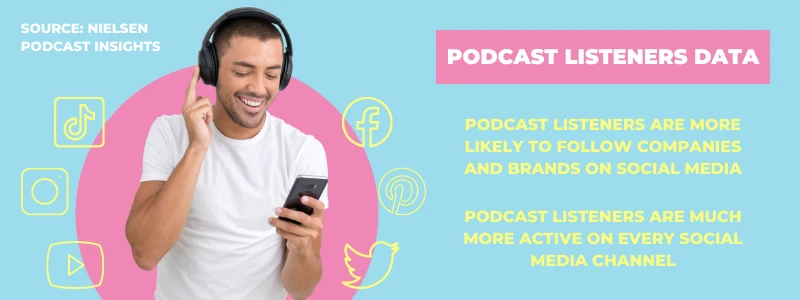
Tier 2: Active Organic Marketing
The second tier of the traffic pyramid is active organic marketing. This tier is all about actively promoting your podcast through various channels. While passive organic marketing focuses on creating high-quality content, active organic marketing focuses on promoting that content to reach a wider audience.
One of the best ways to actively promote your podcast is through social media. Social media platforms like Twitter, Facebook, Instagram, and LinkedIn can be great channels for promoting your podcast and reaching new listeners. Here are some tips to effectively promote your podcast on social media:
- Share your podcast episodes on your social media channels: Whenever you release a new episode, make sure to share it on your social media channels. Be sure to include a link to the episode and a brief description of what listeners can expect.
- Use relevant hashtags: Hashtags are a great way to increase the reach of your social media posts. Research relevant hashtags that your target audience is likely to use and include them in your posts.
- Engage with your followers: Engaging with your followers can help you build a relationship with them and increase the chances that they’ll share your content with their own followers. Respond to comments and messages, and consider asking your followers for feedback on your podcast.
- Leverage email marketing: Email marketing can be a powerful tool for promoting your podcast. Consider sending a regular newsletter to your subscribers that includes links to your latest episodes.
Another way to actively promote your podcast is through guest appearances on other podcasts or YouTube channels. By appearing on other shows, you can reach new audiences and establish yourself as an expert in your niche. Here are some tips to help you get started:
- Research relevant shows: Look for other podcasts or YouTube channels in your niche that have a similar target audience to yours. Reach out to the hosts and offer to be a guest on their show.
- Prepare for your appearance: Before appearing on another show, make sure to prepare your talking points and have a clear understanding of what topics you’ll be discussing.
- Promote your appearance: Once your appearance has been scheduled, promote it on your own social media channels and encourage your followers to tune in.
Finally, you can also actively promote your podcast through paid advertising. This is the fourth and final tier of the traffic pyramid, which we’ll cover in more detail later. But for now, it’s worth noting that paid advertising can be a powerful way to reach new audiences and scale your podcast quickly. However, it’s important to have a solid foundation in place before investing in paid advertising. That means creating high-quality content, building a strong social media presence, and actively promoting your podcast through other channels first.
Two Podcasts That Use Active Organic Marketing:
- The “Smart Passive Income” podcast hosted by Pat Flynn is a great example of a podcast that uses active organic marketing to promote its content. Flynn regularly promotes his show on social media, particularly on Twitter and Instagram, and uses email marketing to reach his audience. In addition, he has a strong presence on YouTube, where he shares behind-the-scenes videos and bonus content related to the podcast.
- “The Joe Rogan Experience” podcast grew from active organic marketing to become one of the most popular shows in the world. Joe Rogan actively promotes his podcast on social media, email marketing, and other channels. He has a huge following on platforms like Instagram and Twitter, which he uses to drive traffic to his podcast.
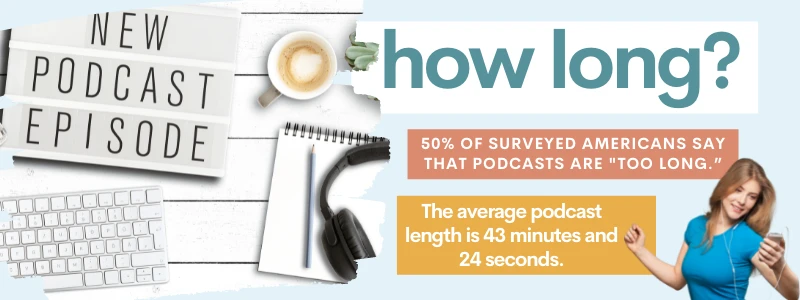
Tier 3: Leverage Other People’s Audiences
The third tier of the traffic pyramid involves leveraging other people’s audiences to expand the reach of your podcast. Collaborating with other podcasters and influencers can be a great way to tap into new audiences and grow your own following.
One effective way to leverage other people’s audiences is through guest appearances on other podcasts. By appearing as a guest on another show, you can introduce yourself and your podcast to a new audience who may be interested in what you have to offer. This can lead to new subscribers, as well as increased exposure for your podcast.
Another way to leverage other people’s audiences is through influencer partnerships. Influencers, whether they are social media personalities, bloggers, or other types of content creators, often have large followings that can be valuable for promoting your podcast. By partnering with influencers in your niche, you can reach their audience and potentially gain new listeners for your show.
When collaborating with other podcasters and influencers, it’s important to approach the partnership as a win-win situation. Offer something of value to the other party, such as a guest spot on your own podcast, or a promotion of their content to your own audience. This will help to build a positive relationship and encourage future collaborations.
Real World Examples
- “How I Built This” is a podcast that interviews successful entrepreneurs and business leaders about their journeys. Host Guy Raz leverages the audiences of his guests by asking them to promote the podcast to their followers and fans.
- The “Armchair Expert” podcast hosted by Dax Shepard is a great example of a podcast that leverages other people’s audiences to grow its own listenership. Shepard regularly invites other celebrities and influencers onto the show as guests, which helps to expose the podcast to new audiences. He also appears on other shows and podcasts, which helps to cross-promote the “Armchair Expert” brand to new listeners.
In summary, leveraging other people’s audiences can be an effective way to grow your podcast audience. By collaborating with other podcasters and influencers, you can tap into new audiences and expand your reach beyond your current following.
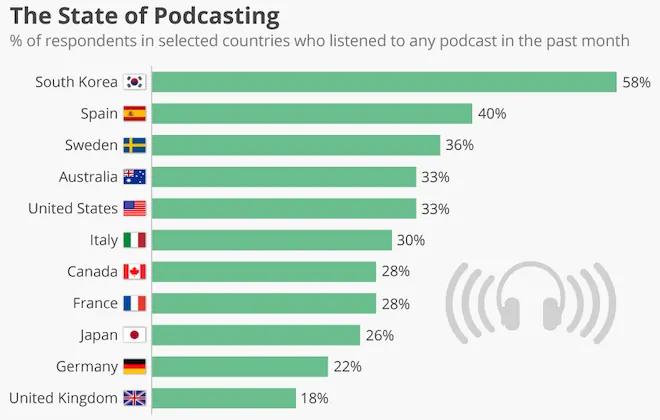
Tier 4: Scaling With Paid Ads
The final tier of the traffic pyramid is scaling with paid ads. This tier involves using paid advertising to reach new audiences and drive traffic to the podcast. Paid advertising can be a highly effective way to amplify the reach of a podcast, but it can also be costly if not executed properly.
There are several platforms that podcasters can use for paid advertising, including Google Ads, Facebook Ads, and Twitter Ads.
Each platform offers unique targeting options and ad formats, so it’s important to understand the strengths and limitations of each one.
When using paid advertising to promote a podcast, it’s important to have a clear understanding of the target audience. This includes demographic information such as age, gender, and location, as well as interests and behaviors. By targeting the right audience, podcasters can ensure that their ads are seen by people who are likely to be interested in their content.
Another key consideration when using paid advertising is the ad format. Some ad formats, such as display ads and video ads, can be highly effective for driving traffic to a podcast. Other formats, such as text ads, may not be as effective for promoting a podcast but can still be useful for building brand awareness.
One potential downside of paid advertising is that it can be costly, particularly if the ads are not optimized for maximum effectiveness. It’s important to monitor the performance of ads carefully and adjust as needed to ensure that they are delivering the desired results.
Real World Examples
- “Serial” is a podcast that gained widespread popularity back in 2014, in part due to its use of paid advertising. The show was promoted heavily through ads on other podcasts, which helped it to reach a wider audience much faster than normal.
- The “How I Built This” podcast hosted by Guy Raz is a good example of a podcast that uses paid advertising to scale its growth. The show is part of the NPR family of podcasts, which has a large advertising budget to work with. As a result, “How I Built This” has been able to run ads on a variety of platforms, including social media, streaming services, and other podcasts. This has helped the show to reach new listeners and to maintain a steady rate of growth over time.
Overall, paid advertising can be a powerful tool for scaling a podcast’s reach and growth. However, it’s important to approach this tier of the traffic pyramid with caution and carefully consider the target audience, ad format, and budget before diving in.
Conclusion
By now, you know that the traffic pyramid is an effective strategy for growing a podcast audience. By understanding the four tiers of the traffic pyramid, podcasters can develop a comprehensive marketing plan to drive traffic to their podcast and grow their audience.
The first tier, passive organic marketing, involves creating high-quality content that is search engine optimized and shareable. The second tier, active organic marketing, involves actively promoting the podcast through social media, email marketing, and other channels. The third tier, leveraging other people’s audiences, involves collaborating with other podcasters and influencers to reach new audiences. Finally, the fourth tier, scaling with paid ads, involves using paid advertising to amplify the podcast’s reach and growth.
It’s important to note that while each tier of the traffic pyramid is essential for growing a podcast audience, not every podcaster may have the resources or budget to execute every tier. However, even implementing one or two tiers can have a significant impact on a podcast’s growth and reach.
It’s also worth mentioning that building a loyal audience takes time, patience, and consistency. Podcasters should focus on creating high-quality content and engaging with their listeners to foster a loyal community.
Start today! Begin implementing the traffic pyramid and focus on developing a comprehensive marketing plan right now. With this you can increase your audience reach, grow your community, and build a successful podcast.
You may even discover that you can sell high-ticket services to your podcast listeners for an additional revenue stream!

